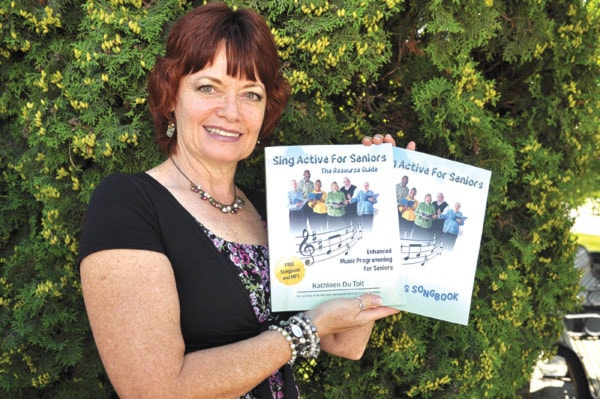Music has the ability to alter moods, whether it be a tune that lifts the spirit, rekindles shadowed memories, encourages sleep or gets people on their feet. Since she began working with seniors at 16, Kathleen Du Toit has always seen the effect music has on older people in particular.
She says music can calm the tantrums of Alzheimer’s and help stroke victims find their voice, if only when they sing.
Du Toit says science has proven that listening to music causes the brain to produce dopamine, which gives a sense of feeling good; raises oxytocin, which is associated with social bonding; reduces cortisol, which is the stress hormone; increases melatonin, which is associated with sleep; and raises levels of immunoglobulin A, which helps to improve the immune system.
Du Toit grew up in a musical family but always wanted to be a nurse. From the beginning, she had no doubt that music and singing was a positive soundtrack in the often difficult or lonely lives of people who must live in facilities.
“It decreases the level of agitation and aggressive behaviours, it improves the overall rating of physical health, increases morale, improves respiratory function and improves circulation,” said Du Toit. “It’s incredibly therapeutic.”
Throughout her career she has developed music programming and shared it in all the facilities and care-homes she frequented. It occurred to her, however, that many facilities lack music programming.
“There’s not a lot of programming available for music and yet music is such an incredibly important part of the treatment of not just older people but anybody,” said Du Toit.
She says recreation and rehabilitation workers often don’t have a lot of music training and, unlike herself, might not be musical people. If they feel they can’t sing or play instruments, they might avoid music programming for the simple reason that they haven’t had a lot of exposure to it.
Because she believes so strongly in the therapeutic benefits of music, Du Toit compiled a 262- page guide for running music programs called Sing Active for Seniors. She describes her initiative as wanting to create a guide much like a cook book: one that workers can use to run programs without having any musical training because all the instructions are outlined.
With the guide she also created a 25-song sing-a-long book with large print and a CD to play and follow along with.
It’s not just about singing and listening, either. There are ideas for how to run sessions with themes and decorating ideas, along with what songs to include. It includes several games that coincide with suggested songs including trivia, “name that tune” and “music bingo.” She’s included quizzes and crosswords, all involving music.
These programs provide new ways to enjoy music every day along with the therapy facts and profiles on how the program benefits seniors and what its purpose is.
“I have seniors that will never go to regular bingo, but they won’t dare miss singing bingo,” said Du Toit.
In all, Sing Active for Seniors references 2,000 songs. Du Toit spent two years compiling all her programs and researching music therapy facts for the book. She says music therapy books are often all theory and don’t provide activities and instruction the way hers does.
The key is that the songs span from about the 1920s to the 1960s.
“It’s all songs that they know, that they’ve grown up with,” said Du Toit. “When you sing these songs it takes them back to when they were younger. It stimulates good feelings and nostalgia.”
Music therapy can reduce depression in older adults and can be structured to enhance social and emotional skills and decrease problem behaviours.
Du Toit says seniors respond to music in different ways but she talks a lot about seniors who have dementia and Alzheimer’s and the positive influence music has on their moods.
Du Toit hopes that Sing Active for Seniors will encourage more music programming in care homes.
For her, the reward of seeing a positive response to music is all she needs.
“If I can brighten up one hour a day for one resident I have fulfilled a purpose to make a difference in the lives of seniors.”
